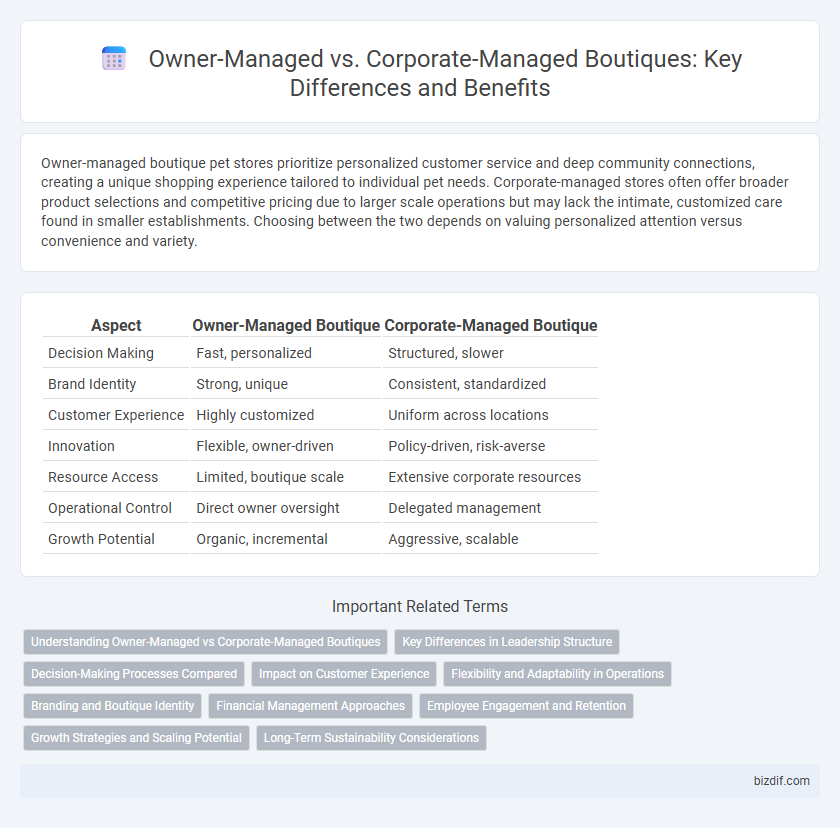Owner-managed boutique pet stores prioritize personalized customer service and deep community connections, creating a unique shopping experience tailored to individual pet needs. Corporate-managed stores often offer broader product selections and competitive pricing due to larger scale operations but may lack the intimate, customized care found in smaller establishments. Choosing between the two depends on valuing personalized attention versus convenience and variety.
Table of Comparison
| Aspect | Owner-Managed Boutique | Corporate-Managed Boutique |
|---|---|---|
| Decision Making | Fast, personalized | Structured, slower |
| Brand Identity | Strong, unique | Consistent, standardized |
| Customer Experience | Highly customized | Uniform across locations |
| Innovation | Flexible, owner-driven | Policy-driven, risk-averse |
| Resource Access | Limited, boutique scale | Extensive corporate resources |
| Operational Control | Direct owner oversight | Delegated management |
| Growth Potential | Organic, incremental | Aggressive, scalable |
Understanding Owner-Managed vs Corporate-Managed Boutiques
Owner-managed boutiques emphasize personalized customer experiences and maintain tight control over branding and product selection, fostering unique market positioning. Corporate-managed boutiques benefit from scalable resources, standardized operational procedures, and broader marketing reach, enabling rapid expansion and consistent service quality. Understanding these differences helps in choosing the right management style aligned with business goals and customer expectations in the boutique retail sector.
Key Differences in Leadership Structure
Owner-managed boutiques are characterized by direct oversight and decision-making from the proprietor, fostering a personalized leadership style and rapid adaptability. Corporate-managed boutiques operate under a hierarchical framework with designated executives and standardized procedures, ensuring consistent policies across departments. The key difference lies in the degree of autonomy and involvement of the owner versus structured governance and scalability.
Decision-Making Processes Compared
Owner-managed boutiques typically feature streamlined decision-making processes with the owner directly overseeing operations, allowing swift and flexible responses to market changes. Corporate-managed boutiques often implement hierarchical decision-making structures involving multiple departments and stakeholders, leading to more formalized but potentially slower decisions. The contrast impacts agility, with owner-managed boutiques prioritizing personalized strategies and corporate entities emphasizing standardized procedures.
Impact on Customer Experience
Owner-managed boutiques often deliver personalized customer experiences through direct involvement and tailored service, fostering strong customer loyalty and unique brand identity. Corporate-managed boutiques leverage standardized processes and extensive resources to ensure consistent quality and wider product availability, enhancing reliability but sometimes limiting individuality. The impact on customer experience hinges on the balance between personalized attention and operational efficiency, with owner-managed stores prioritizing intimacy and corporate-managed stores emphasizing consistency.
Flexibility and Adaptability in Operations
Owner-managed boutiques excel in flexibility and adaptability, allowing swift decision-making and personalized customer experiences that respond quickly to market trends. Corporate-managed boutiques often operate within standardized frameworks, which can limit rapid adjustments but benefit from established operational protocols and resource sharing. This contrast impacts how each model navigates inventory management, marketing strategies, and customer engagement in dynamic retail environments.
Branding and Boutique Identity
Owner-managed boutiques often maintain a unique, authentic brand identity reflecting the personal vision and passion of the proprietor, creating strong emotional connections with customers. Corporate-managed boutiques prioritize consistent branding and standardized operations, enhancing scalability but potentially diluting the boutique's distinctiveness. The balance between personalized branding and operational consistency defines the boutique's market positioning and customer loyalty.
Financial Management Approaches
Owner-managed boutiques typically adopt hands-on financial management, emphasizing personalized budgeting, cash flow control, and direct oversight of expenses to maintain agility and close cost monitoring. Corporate-managed boutiques often implement standardized financial protocols, leveraging advanced financial software, structured reporting systems, and formalized budgeting processes to ensure scalability and regulatory compliance. Both approaches impact profitability, with owner-managed boutiques favoring flexibility and corporate-managed entities prioritizing structured financial governance.
Employee Engagement and Retention
Owner-managed boutiques often benefit from higher employee engagement and retention due to personalized leadership and a strong sense of community. Employees in these settings feel more valued and directly involved in business decisions, fostering loyalty and long-term commitment. In contrast, corporate-managed boutiques may struggle with higher turnover rates as standardized procedures and hierarchical structures can reduce individual recognition and job satisfaction.
Growth Strategies and Scaling Potential
Owner-managed boutiques often leverage personalized customer relationships and niche market expertise to drive organic growth, enabling flexible and adaptive scaling strategies. Corporate-managed boutiques benefit from extensive resources, standardized processes, and economies of scale, facilitating rapid expansion and broader market penetration. Strategic investments in digital marketing, supply chain optimization, and brand partnerships are key drivers for scaling potential in both ownership models.
Long-Term Sustainability Considerations
Owner-managed boutiques often prioritize personalized customer experiences and maintain strong community ties, which can enhance brand loyalty and long-term sustainability. Corporate-managed boutiques typically have greater resources for marketing and expansion, but may face challenges in preserving unique brand identity and adaptability. Sustainable growth depends on balancing operational efficiency with authentic customer engagement.
Owner-managed vs Corporate-managed Infographic

 bizdif.com
bizdif.com